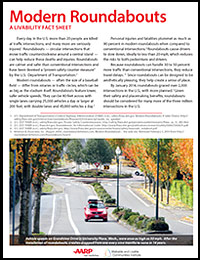AARP Livability Fact Sheet - Roundabouts
Here’s why driving around in circles is a good thing
Every day more than 20 people are killed at traffic intersections in the United States, and many more are seriously injured.
Roundabouts — circular intersections that move traffic counterclockwise around a central island — can help reduce these deaths and injuries. Because traffic roundabouts are calmer and safer than conventional intersections, they’re a “proven safety counter-measure,” says the U.S. Department of Transportation’s Federal Highway Administration.
The fact sheet Modern Roundabouts explains the benefits of circular intersections and addresses the misconceptions many have about creating and living with traffic roundabouts.
Key Points
First, some terminology: Modern roundabouts — often the size of a baseball diamond or infield — differ from rotaries or traffic circles, which can be as big as the entire outfield. Second: Modern roundabouts can be 80 feet across with single lanes carrying 25,000 vehicles per day, or they can be larger at 200 feet across with double lanes and the ability to handle 45,000 vehicles daily.
3 Benefits of Modern Roundabouts (the fact sheet has more)
- Because modern roundabouts eliminate the need to make a left-hand turn, which can be challenging for many drivers and is a frequent cause of collisions, the risk of head-on and right-angle crashes are also eliminated. In addition, the number of potential vehicle-to-vehicle and vehicle-to-pedestrian are greatly reduced. (See the illustration below.)
- Because modern roundabouts can manage 30 to 50 percent more traffic than conventional intersections, they reduce travel delays. (Check out the video proving this point from the Discovery Channel's MythBusters program.)
- Because modern roundabouts feature lower, safer vehicle speeds, which also requires approaching drivers to slow down, pedestrian and driver risks are reduced.
As of January 2014, more than 2,000 traffic intersections in the United States had been constructed as a roundabout or renovated to be one.
3 Myths About Roundabouts — Busted!
The authors address various myths and truths about roundabouts. Here are a few:
- Myth: "Roundabouts hurt business."
One example why that's not so: In Golden, Colorado., retail sales increased 60 percent after the addition of a string of roundabouts — and that was during the 1989 recession. Sales in Golden outpaced those of all other cities in the state.
- Myth: "Fire trucks, snowplows, buses and semis can't use roundabouts."
By including a “truck apron” in the center of the circular space, a roundabout can indeed accommodate emergency vehicles, snow plows and large trucks.
- Myth: "Roundabouts don’t work for pedestrians or bicyclists."
By using space to pause on the “splitter island” in the center of the roundabout, pedestrians and bicyclists need to watch only one direction of traffic at a time, which simplifies the task of crossing the street.
How to Use
Because the fact sheets in the Livability series are only four pages each, the materials are quick and easy to read online or to download and print for sharing.
The “Modern Roundabouts” fact sheet can be used by policy makers, transportation planners, community leaders and citizen activists to educate themselves and others about the benefits of modern roundabouts for traffic management, economic development, public health and safety and the quality of life for residents of all ages.
Stay Informed — For Free!
AARP.org/Livable
Enter a topic, name, place, etc.





